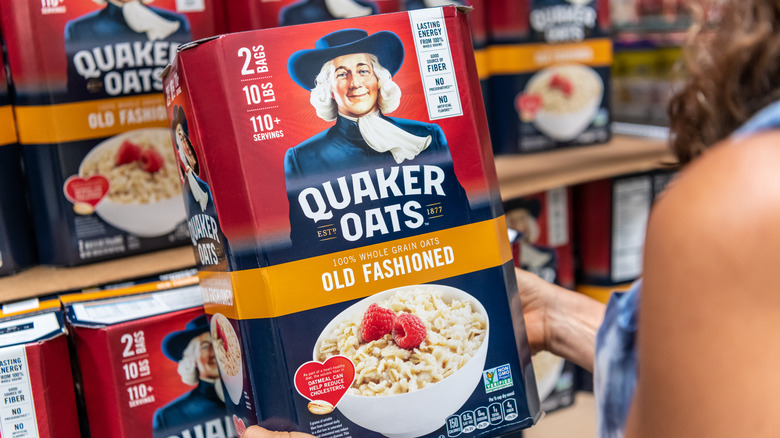The Quaker Oats Scandal You've Probably Never Heard Of
Everything about Quaker Oats rings wholesome on the surface. For one thing, there's the simple, classic design of its packaging: The Quaker Oats Company's relatively modest line of products fits neatly into three categories (old-fashioned oats, quick oats, and snacks). For another, there's also each product's clearly labeled ingredients and the nutritional benefits they carry. And, of course, there's the brand's rosy-cheeked spokesman: William Penn, who's been smiling proudly in all his apple-cheeked, countryman-hatted glory since 1877, per The Chicago Sun-Times.
However, for all the respectability the Quaker Oats Company espouses, the company is not without its scandals. In 2018, an environmental research and advocacy organization named the Environmental Working Group found traces of the potentially carcinogenic herbicide glyphosate in boxes of Cheerios, Quaker Oats, and other breakfast products. The discovery resulted in class-action lawsuits against Quaker Oats in both New York and California (via The New York Times). But if you turn back the clocks to the 1940s and 1950s, you'll find another Quaker Oats scandal that makes a little weed-killer look like child's play.
Radioactive oatmeal for the children
As we know from countless period dramas, boarding schools and other such institutions for children have sadly played host to all kinds of abuse and sinister activity throughout history. (Take the distribution of benzodiazepines to orphans in the 1960s, as seen in the Netflix series "The Queen's Gambit," for instance.) For the young constituents of the science club at Fernald State School in Waltham, Massachusetts in the 1940s and 1950s, mistreatment took the form of their daily serving of Quaker oatmeal, which was laced with radioactive tracers (per Smithsonian magazine).
Originally called the Massachusetts School for the Feeble-Minded, Fernald housed "mentally disabled children along with those who had been abandoned by their parents," per Smithsonian magazine. Bolstered by the support of MIT and the Atomic Energy Commission, a local nutrition professor used the members of the school's science club, who were between the ages of 10 and 17, to exercise three experiments involving radioactive iron and calcium. The experiments were meant to prove that the nutrients in Quaker oatmeal "travel throughout the body," according to one piece published by The Washington Post in 1998. The article also noted that reports of the experiments weren't made public until 1994.
All things considered, it appears Quaker Oats was far from unaware of its role in these abusive experiments. As the Post reported at the time, the brand ponied up a $1.85 million settlement alongside MIT in 1998, officially putting the scandal to rest.

